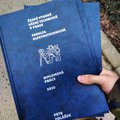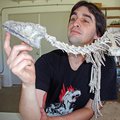 Thanks John and Dan for putting this one on!
Thanks John and Dan for putting this one on!
![]() @tubetime do you think you can sort of chip away the last layer very carefully?
@tubetime do you think you can sort of chip away the last layer very carefully?

https://hackaday.io/event/177775-retro-recreations-hack-chat
![]() @devinsbench yes but i can't do it without scratching the die
@devinsbench yes but i can't do it without scratching the die
 Thank you. I will reach out
Thank you. I will reach out
![]() Aah
Aah
![]() @tubetime lol
@tubetime lol
![]() I still have the corpse here if you want it...
I still have the corpse here if you want it...
 Thank you @JohnDMcMaster ! It's always a pleasure to follow your twitter account.
Thank you @JohnDMcMaster ! It's always a pleasure to follow your twitter account.
![]() Is it a test equipment corpse?
Is it a test equipment corpse?
![]() I can stick around for a bit more if people want to chat
I can stick around for a bit more if people want to chat
![]() I might just multitask a bit more
I might just multitask a bit more
 Cool, I'll wait a bit to pull a transcript. Thanks!
Cool, I'll wait a bit to pull a transcript. Thanks!
![]() This will probably get decapped soon:
This will probably get decapped soon:
![]() A few people requested these low cost caliper (oops)
A few people requested these low cost caliper (oops)
 @JohnDMcMaster multitasking is great but please just don't drink nitric acid instead of your coffee
@JohnDMcMaster multitasking is great but please just don't drink nitric acid instead of your coffee
![]() spicy
spicy
![]()
https://www.youtube.com/watch?v=GX4KcLDCiII
![]() I'm also excited about this. I'm curious if anyone has guesses what I'm doing with that
I'm also excited about this. I'm curious if anyone has guesses what I'm doing with that
![]() Laser?
Laser?
 Exposing some photopolymer?
Exposing some photopolymer?
 surface acoustic wave typification?
surface acoustic wave typification?
![]() @devinsbench laser is a good guess, haven't heard that one yet (but not it)
@devinsbench laser is a good guess, haven't heard that one yet (but not it)
 I think you've been interested in recovering configuration in SPLDs for reverse engineering, is it done by simple observation or has it to be done electrically? I suppose it would be different from a OTP array and a EEPROM array?
I think you've been interested in recovering configuration in SPLDs for reverse engineering, is it done by simple observation or has it to be done electrically? I suppose it would be different from a OTP array and a EEPROM array?
![]() I have a spare unit I'm going to try to revive (missing lamp) using a parts laser someone else has
I have a spare unit I'm going to try to revive (missing lamp) using a parts laser someone else has
![]() Hi @Antoine Bercovici ! Yes, what you can do depends a lot on the specific technology. Sometimes for example the interface is secured or maybe even the protocol is unknown so it makes more sense to use brute force imaging to extract bits
Hi @Antoine Bercovici ! Yes, what you can do depends a lot on the specific technology. Sometimes for example the interface is secured or maybe even the protocol is unknown so it makes more sense to use brute force imaging to extract bits
![]() Ex: EEPROM is hard to see under a microscope (usually SEM, sometimes AFM) so usually other methods are used (ex: disable security or microprobe bus)
Ex: EEPROM is hard to see under a microscope (usually SEM, sometimes AFM) so usually other methods are used (ex: disable security or microprobe bus)
 Dan Maloney
Dan Maloney
Discussions
Become a Hackaday.io Member
Create an account to leave a comment. Already have an account? Log In.